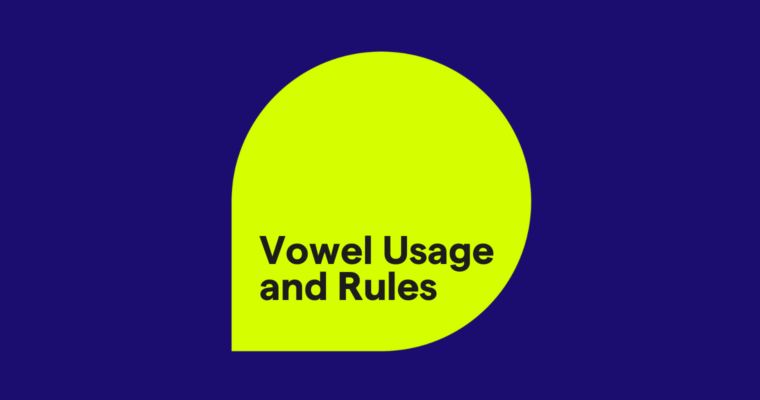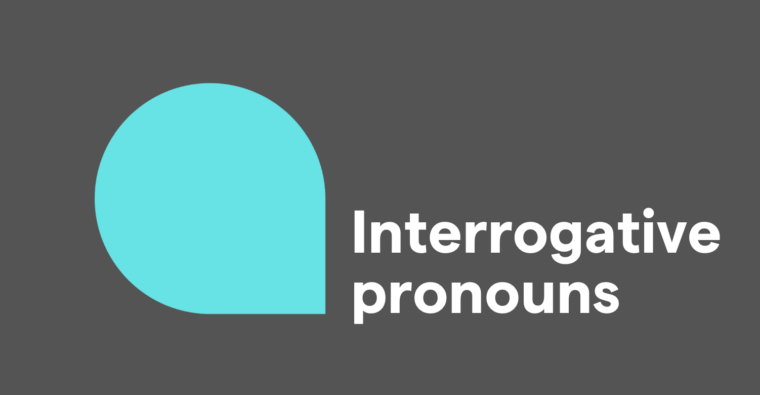
Key takeaways:
- Vowels are the letters a, e, i, o, u, and sometimes y. They’re the sounds we make with an open mouth, and they’re found in every word and syllable.
- Vowels can be monophthongs (single sounds), diphthongs (two sounds), or triphthongs (three sounds), each affecting pronunciation.
- Short vowels appear in single-vowel words, while long vowels often result from vowel combinations, which change pronunciation and spelling.
Vowels are letters that represent speech sounds produced when air leaves the mouth without blockage by the tongue, lips, or throat. The vowel letters in the English alphabet are a, e, i, o, u, and sometimes y. All other letters in the English alphabet are consonants, representing sounds where airflow is blocked.
While there are only a few of them in English, vowels are important in spelling, pronunciation, and grammar. They appear in every word and form the foundation of the English language’s sound system. This guide explores what vowels are, how they function, and why they’re crucial for English communication.
Table of contents
What are vowels?
Vowels are speech sounds produced without any blockage of air by the lips, tongue, or throat. In contrast, consonants are sounds where airflow is obstructed before leaving the mouth. Letters and speech sounds are divided into these two categories based on how air moves through the vocal tract.
Vowels are essential in spelling, pronunciation, and grammar, and they influence how consonants are used, such as when spelling words with double consonants. For example, the presence of a vowel can determine whether a consonant is doubled when adding a suffix to form the present participle.
- hop → hopping (double consonant before -ing)
- hope → hoping (silent e changes the conjugation rule)
The silent e at the end of a word modifies spelling rules and affects how words are conjugated. For example, when a verb ends in a silent e, the e is simply replaced with -ing.
Vowels vs. consonants
While consonant sounds are differentiated by how the air is blocked—such as sticking the tongue behind the front teeth for d and t or closing the lips for b, m, and p—vowel sounds are differentiated by pitch, accent, volume, and duration.
The letters a, e, i, o, u—and sometimes y—are vowels. However, some consonants (like h, r, and w) can also make vowel sounds. Despite this, these letters are still classified as consonants in grammar and don’t follow vowel rules.
Short vs. long vowels
There are six vowels in the English alphabet (though “y” sometimes acts as a consonant). These vowels combine in various ways to create over a dozen distinct sounds in American English. To keep things simple, we can divide these vowel sounds into two categories: short vowels and long vowels.
Short vowels
Short vowels are the standard pronunciation of vowels—usually when there is only one vowel in the word, especially in short words.
- a as in cat
- e as in wet
- i as in big
- o as in clock
- u as in but
Long vowels
Long vowels are a little more complex. They often occur when a word contains two vowels, though they may not always appear together. In many cases, one vowel influences the other, making the sound resemble the vowel’s name. For example, the long vowel sound in eat is pronounced like the name of the letter e.
- a as in cake
- e as in street
- i as in like
- o as in phone
- u as in use
If you can perfect these vowel sounds, you can tackle most of the English words you’ll come across and improve your spelling when you write.
Is y a vowel?
The letter y acts as a consonant when it starts a syllable, producing a distinct sound, and as a vowel when it appears in the middle or end of a syllable, mimicking the sound of i or e.
When y is a consonant, it makes its distinct sound by using the rear of the tongue on the top of the mouth. Consider the pronunciation of words like these:
- yellow
- yogurt
- yarn
However, when y is a vowel, it imitates either the long or short vowel sound for i or the long vowel sound for e.
- my (long i)
- shy (long i)
- system (short i)
- crypt (short i)
- lady (long e)
- hairy (long e)
Unlike the other consonants, y counts as a vowel; some words only include a y and no other vowels.
- fly
- sky
- gym
- myth
How vowel sounds change
Vowels are classified based on the position of the tongue and other articulators in the mouth. Let’s explore the three primary vowel categories: monophthongs, diphthongs, and triphthongs.
Monophthongs
Monophthongs are vowels that produce a single, unchanging sound. They are the simplest of the three types of vowels. The tongue remains stable throughout the pronunciation, producing a steady, clear sound.
Examples in the English language include:
- The o in pot
- The a in cat
- The e in bed
Diphthongs
Diphthongs consist of two vowel sounds within the same syllable, with one sound gliding smoothly into the next. This creates a dynamic, changing sound as the tongue shifts position during pronunciation.
Examples of diphthongs in English include:
- buy (buh-AI)
- tourist (TOO-rist or TOR-ist)
- day (DUH-ay)
Triphthongs
Triphthongs are the most complex of the three types of vowel sounds. They consist of multiple vowel sounds that glide from one to another, creating an intricate sound sequence in a single syllable.
Examples of triphthongs in English include:
- player (PLEH-uh or PLEI-er)
- hour (OUR)
- mower (MOH-er)
Vowel usage
Vowels play a crucial role in how we perceive, pronounce, and understand the meaning of words.
Syllable formation
Syllables form the foundation of words, and vowels play an important role in their structure. Each syllable usually contains at least one vowel, which influences the rhythm and flow of a word.
Below are some simple guidelines to help understand this concept:
- Every syllable has at least one vowel: A syllable can’t exist without a vowel sound. Even if the vowel is y, it still counts as a vowel in that syllable.
- Vowels can appear alone or with consonants: A syllable can have just one vowel (like in cat) or a combination of vowels and consonants (like in rain).
- Vowel placement affects the word’s rhythm: For example, words like banana (with repeating open syllables) sound different from words like strength (with a tighter, more compact sound).
By understanding how vowels shape syllables, you can improve the clarity and flow of your writing or speech.
Pronunciation variations
Vowel pronunciation is influenced by their position and the surrounding consonants. For instance, adding e to pin to form pine alters both the sound and meaning. Silent vowels like this are common in English, creating distinctive pronunciation patterns that often follow predictable rules.
In addition to silent vowels, English has many vowel combinations (like ea, oa, ui, etc.) that can change pronunciation. For example:
- ea can sound like a long e in beat or a short e in “bread.”
- oa usually makes a long o sound, as in “boat.”
- ui can sound like a long u, as in fruit, or a short i, as in “build.”
These vowel combinations can complicate pronunciation, but recognizing patterns and exceptions can help make them easier to understand.
Impact on meaning
Vowels can impact the meaning of a word. You’ll see this often in languages like English, where a change in vowels can directly alter the meaning of the word. For example, changing the vowel in a three-letter word, like from tip to tap, significantly changes the word’s meaning.
Influence on consonant usage
Vowels affect how consonants are pronounced in words. For example, consonants may harden or soften depending on the adjacent vowel sounds. Consider how the letter c sounds in cat versus city. The vowels surrounding consonants can shape how they are understood in various contexts.
Literary devices
Vowels are crucial to many literary devices, such as rhymes and assonance. Vowel sounds provide rhythm and flow, which helps make writing more engaging to readers. You can use vowel sounds to create an emotional impact in writing styles like poetry. For example:
- Long vowels can create a calm feeling, as in the line “The moon glows slowly over the shining sea,” where the long o sounds give a peaceful vibe.
- Short vowels can make the tone feel sharper, as in the line “The wind whips through the shutters,” where the short i sounds express pain or anger.
- Repeating vowel sounds can emphasize emotion, such as in “She seemed to sleep, deep in a dreamless peace,” where the long e sounds underscore the feeling.
Refine your vowel usage to enhance your writing
Vowels play a subtle yet powerful role in shaping the sound and tone of your writing. By learning their function, you can craft sentences that are clear and engaging, making them pleasant to read aloud.
Polish your writing with Grammarly
Elevate your writing with Grammarly, a powerful and easily accessible software platform that catches spelling and grammar mistakes. With its free option, Grammarly helps you fine-tune your work to craft clear, accurate, and polished content that boosts your writing confidence.
Vowel FAQs
Have a few lingering questions about vowels? Below are frequently asked questions to help clarify their role in language and their usage in various contexts.
What’s the difference between short and long vowels?
The same vowel can make different sounds depending on whether it’s paired with another vowel. When a vowel is alone in a syllable, it produces a short vowel sound, such as the i in big.
When vowels are combined with another vowel, typically a silent vowel, they can make a long vowel sound that’s usually pronounced like the letter’s name. For example, the ea in eat sounds like the name of the letter e.
Does every word need a vowel?
Unlike consonants, every word needs at least one vowel. While there are a small number of exceptions, which we explain below, this is generally the rule. The shortest words in the English language are one letter, and they are both vowels: the article a and the pronoun I.
Every syllable also needs a vowel sound. If a word has more than one syllable, it then needs more than one vowel.
Are there words with no vowels?
There are only a handful of English words without proper vowels, and they’re mostly loan words from Welsh. They use a rare vowel form of the letter w that is not usually accepted in English.
- crwth—a Welsh violin-like instrument
- cwtch—a hiding place
- cwm—a hollowed-out area in a mountain
None of these words are common in everyday English, so we advise against using them in your communication or writing (unless it’s directly related to Wales).
What 5-letter word has the most vowels?
The five-letter word with the most vowels is Iouea (with a capital i), which uses all the main vowels and no consonants (Iouea is the scientific name for a genus of extinct water sponges).
If you’re asking this question because of Wordle, try adieu, an English loan word of five letters containing every vowel except o.
What is assonance?
Assonance is a literary device that uses a series of words with the same vowel sounds. It is the vowel version of consonance, which repeats consonant sounds. Both assonance and consonance are common in works where sound is important, such as poetry, music lyrics, and creative writing.
For example, look at this passage from Edgar Allan Poe’s poem “The Raven”:
“And the silken, sad, uncertain rustling of each purple curtain
Thrilled me—filled me with fantastic terrors never felt before.”
Words like silken, uncertain, and curtain use similar vowel sounds, as do the words terrors, never, and before.





